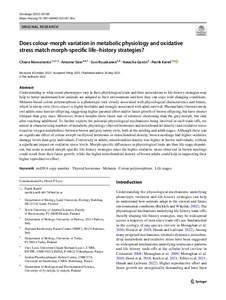Does colour-morph variation in metabolic physiology and oxidative stress match morph-specific life–history strategies?
Morosinotto, Chiara; Stier, Antoine; Ruuskanen, Suvi; Garcin, Natacha; Karell, Patrik
Does colour-morph variation in metabolic physiology and oxidative stress match morph-specific life–history strategies?
Morosinotto, Chiara
Stier, Antoine
Ruuskanen, Suvi
Garcin, Natacha
Karell, Patrik
Springer Science and Business Media LLC
Julkaisun pysyvä osoite on:
https://urn.fi/URN:NBN:fi-fe2025082787734
https://urn.fi/URN:NBN:fi-fe2025082787734
Tiivistelmä
Understanding to what extent phenotypes vary in their physiological traits and their associations to life-history strategies may help to better understand how animals are adapted to their environment and how they can cope with changing conditions. Melanin-based colour polymorphism is a phenotypic trait closely associated with physiological characteristics and fitness, which in tawny owls (Strix aluco) is highly heritable and strongly associated with adult survival. Pheomelanic (brown) tawny owl adults raise heavier offspring, suggesting higher parental effort and/or faster growth of brown offspring, but have shorter lifespan than grey ones. Moreover, brown morphs show faster rate of telomere shortening than the grey morph, but only after reaching adulthood. To further explore the potential physiological mechanisms being involved in such trade-offs, we aimed at characterizing markers of metabolic physiology (thyroid hormones and mitochondrial density) and oxidative stress (reactive-oxygen metabolites) between brown and grey tawny owls, both at the nestling and adult stages. Although there was no significant effect of colour morph on thyroid hormones or mitochondrial density, brown nestlings had higher oxidative damage levels than grey individuals. Conversely in adults, mitochondrial density was higher in brown individuals, without a significant impact on oxidative stress levels. Morph-specific differences in physiological traits are thus life-stage dependent, but seem to match morph-specific life-history strategies since the higher oxidative stress observed in brown nestlings could result from their faster growth, while the higher mitochondrial density of brown adults could help in supporting their higher reproductive effort.
Kokoelmat
- Rinnakkaistallenteet [27094]
